We know all about elephants as they are today. But these now extinct ancestral elephants once walked the earth with the same might and pride.
Today, there are only three living species of elephants (proboscideans) - The Asian elephant, the African bush elephant, and the African forest elephant. But long ago, this mammalian order was quite diverse! Its history began 55-million years ago with Phosphatherium - a now-extinct elephant species. Since then, elephants have shown an assorted genetic makeup to become the world's most iconic megafaunal family with as many as 14 reported genomes. These elephants differed vastly based on their shape, size, and habitat. Which only points to interbreeding. Let us take the example of savannah elephants and woolly mammoths. While they do share common ancestors, they eventually split into separate species, which is quite evident from the way their tusks looked.
As many as 180 elephant species are today extinct. Most of these names won't exactly roll off your tongue, but these elephants have been some of the most important ancestors that researchers have identified. This World Elephant Day, let us get to know a few of the prehistoric elephants that have been a part of the functioning of some amazing but former ecosystems of the animal kingdom.
Habitat: Plains and woodlands of central Asia
Temporal Range: Late Miocene to Early Pliocene
Size and Weight: About 15 feet and weighed between 2 to 3 tonnes
Diet: Plants
 A 3D rendering of Stegotetrabelodon depicted on a grassy hill
A 3D rendering of Stegotetrabelodon depicted on a grassy hill
Stegotetrabelodon (greek for ‘four roofed tusks’) was native to, very surprisingly, the Arabian Peninsula! While it today remains a desert, back in the time, the Arabian Peninsula was theorised to be a subtropical forest with abundant vegetation. A few of these elephants wandered to Africa, where one Stegotetrabelodon (S. syrticus ) grew as tall as 4 metres in height and weighed between 11 to 12 tonnes. In the year 2012, researchers came across preserved footprints of a Stegotetrabelodons herd in the Middle East. These more than a dozen elephant footprints, varying across age and sex, have been termed as one of the most important ancestral elephant discoveries of our time. This discovery also supports the theory that the Arabian desert we know today was once home to mega-faunal mammals.
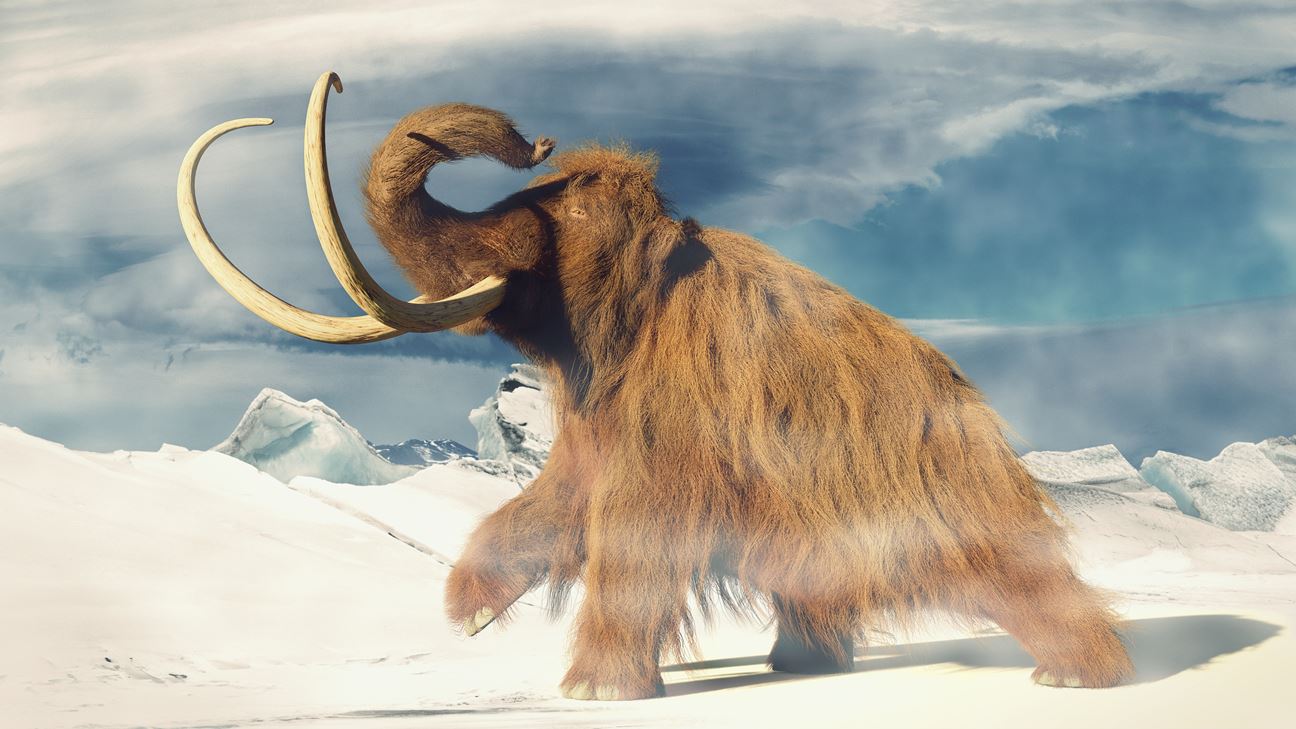
Habitat: Northern Asia, many parts of Europe, and the northern part of North America
Temporal Range: Middle Pleistocene - Late Holocene
Size and Weight: Up to 11 feet and 6 tonnes
Diet: Herbaceous Vegetation
The tundra and most parts of the taiga were once home to these “mammoth steppe”. Woolly Mammoths were quintessential representatives of the Ice Age, so it is hardly a surprise that their coat was made up of foot-long hair with an undercoat of shorter hair. These grazers roamed around ecosystems with abundant grasses and shrubs. Even 10,000 years after their disappearance, these remain one of the most popular prehistoric elephants. Today, the woolly mammoth DNA is with the scientists who plan on reviving the species in an attempt to convert the tundra back into a grasslands ecosystem. While this is only theoretically possible, who knows we may soon see a woolly (or maybe not so woolly) mammoth!
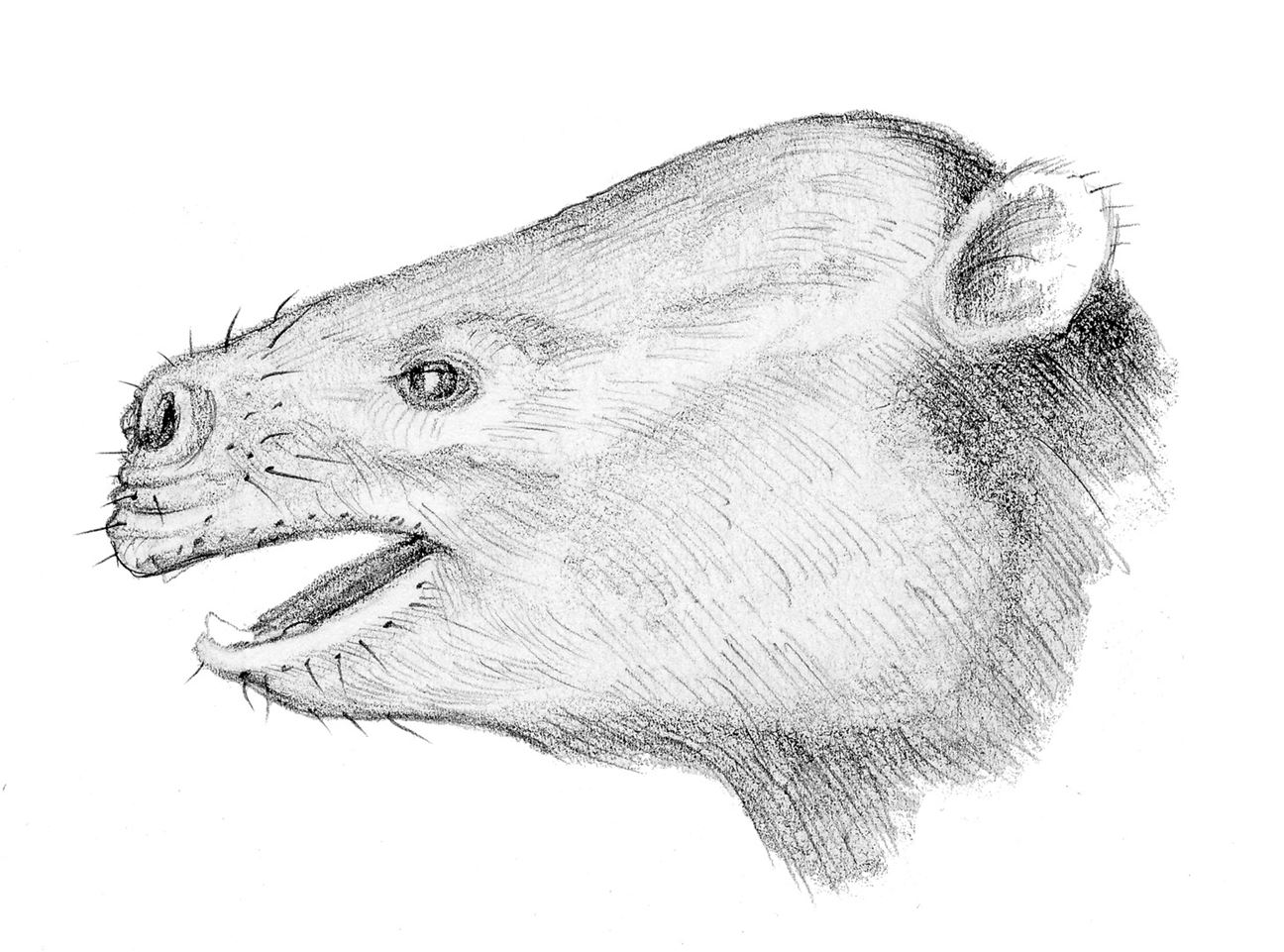 Phosphatherium hand drawn By DagdaMor / Wikimedia Commons / CC BY-SA 4.0
Phosphatherium hand drawn By DagdaMor / Wikimedia Commons / CC BY-SA 4.0
Habitat: Woodlands of North Africa
Temporal Range: Late Paleocene to Ypresian
Size and Weight: About 3 feet long and 15 to 20 kilograms
Diet: Herbaceous Vegetation
Can you imagine an elephant the size of a dog? But some 60 million years ago, this small, pig-shaped elephant walked the plains of Africa. This animal seemed to look like a combination of a horse and a hippopotamus. Quite confusing for the palaeontologists indeed. But fossil study confirmed that Phosphatherium had a proboscis lineage (a taxonomic order of the one currently living family (Elephantidae) and several other extinct elephant families) based on the skeletal structure of its skull and its teeth. Phosphatherium is believed to have enjoyed an amphibious lifestyle while munching on the tasty vegetation in northern Africa.
Habitat: All of North America
Temporal Range: Early Pliocene - Late Pleistocene
Size and Weight: Between 7 feet (females) to 10 feet (males) and up to whopping 6 tonnes
Diet: Herbaceous Vegetation
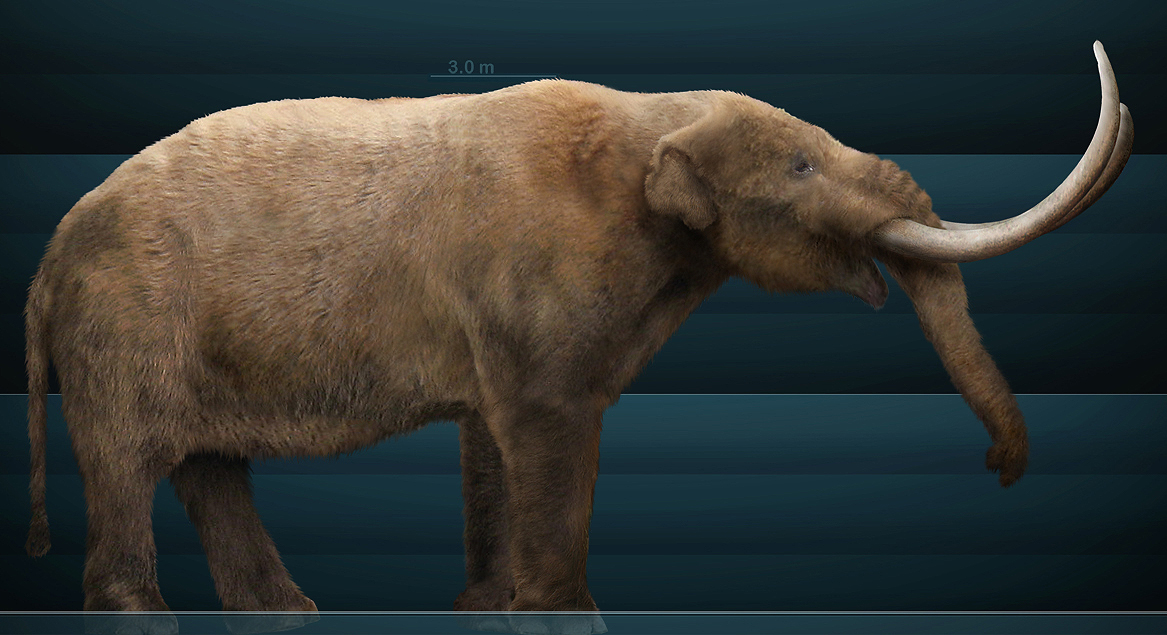
Restoration of an American mastodon By Sergiodlarosa / Wikimedia Commons / CC BY-SA 3.0
This larger-than-life mastodon roamed the plains of North America until 13,000 years ago! Mastodons went extinct as a part of mass extinction, which is believed to have resulted from human predation and climate change. These giants often get confused with their cousins - the mammoths, but mastodons were distinctively shorter and stockier. However, their most distinctive feature was the cheek teeth. Their molars were cusp-shaped which gave them the name "mastos" meaning breast and “odon(t)” meaning tooth, both Greek words. Complete or near-complete American mastodon skeletons have been recovered and are now well-preserved.
Habitat: Jungles of Eurasia
Temporal Range: Late Miocene–Early Pleistocene
Size and Weight: 10 feet tall and 1 to 2 tonnes
Diet: Herbaceous Vegetation
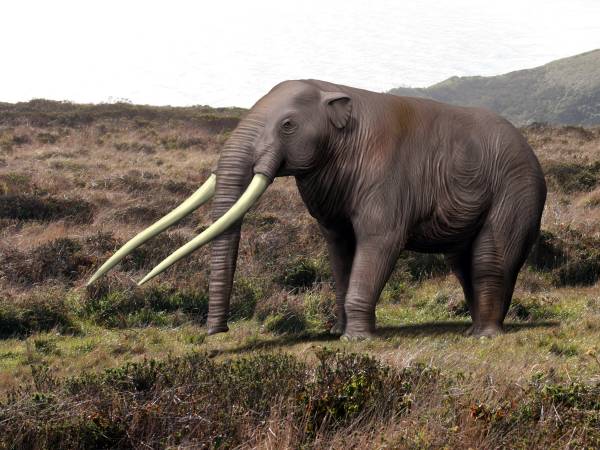
Anancus By Nobu Tamura / Wikimedia Commons / CC BY-SA 4.0
They may not be the largest, but the Anancus’s elongated tusks did stand out! Sometimes, as long as its body, its tusks grow up to 4 metres! These especially long tusks helped Anancus feed on vegetation that was way beyond the capabilities of other herbivores. They used their tusks to first uproot the plants, and later, using its trunk, these elephants would pick the plants and munch on them. A well preserved Anancus tusk, believed to be 3.4 to 2.6 million years of age, was excavated from the sediments of Tatrot village in northern Pakistan (a part of the upper Siwaliks range). Surprisingly, this elephant tusk was the longest ever discovered in South Asia and was measured at a whopping 8.11 feet! (or 271.8 centimetres) Anancuses were believed to have originated in Asia and later entered Europe.
Habitat: Swampy lands of North America, Eurasia, and Africa
Temporal Range: Early Miocene–Middle Miocene
Size and Weight: About 13 feet and weighing between 4 to 5 tonnes
Diet: Plants
 G. angustidens by Charles R. Knight
G. angustidens by Charles R. Knight
Gomphotherium is unlike any elephant that we have ever seen before! Their scoop-shaped lower tusks give an impression that their mouth stays open. But in fact, this shovel-like tusk gave these elephants a great evolutionary advantage. It had four tusks - two on the upper jaw and two along the lower jaw. The lower two tusks were parallel to one another, acting just like a big scooper. This helped them scoop vegetation off the mud, flooded swamps, and river beds. Often called the welded beasts, these elephants had a rather longer geographical range. Researchers found that Gomphotherium roamed across North America, Eurasia, Africa, and even parts of Asia. Tetralophodon and Primelephas are two more elephant species with somewhat similar shovel-like lower jaws. These two were also known to have roamed the woodlands all across the world.
- Cyprus Dwarf Elephant (Palaeoloxodon cypriotes)
Habitat: A few small islands in the Mediterranean Sea
Temporal Range: Pleistocene to Modern
Size and Weight: About six feet and 250 kilograms
Diet: Herbaceous Vegetation
The Cyprus Dwarf Elephant is a classic example of phyletic dwarfism, more so insular dwarfism where large-bodied animals evolve into smaller sized individuals due to many island-like conditions, including limited food resources and fewer predators. Remains of fully developed Palaeoloxodon Cypriotes suggest that these elephants did not weigh more than 250 kilograms, a massive weight reduction from their ancestors. Researchers discovered close to 44 molars on the island of Cyprus that confirm that these elephants descended from the straight-tusked elephant species.
Habitat: Swamps and flood lands of Northern Africa
Temporal Range: Late Eocene-Early Oligocene
Size and Weight: Grew about 12 feet and weighed close to 2 tonnes
Diet: Herbaceous vegetation
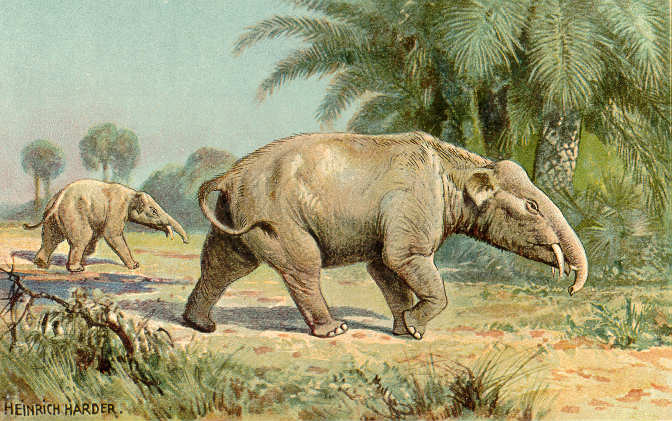
Artistic representation of Palaeomastodon by Heinrich Harder
Their long and flat skulls and two pairs of tusks definitely distinguish the Palaeomastodon from other mastodons. Palaeomastodon with their upper pair of tusks used to scrape bark off the trees, while the lower pair of tusks helped them scoop food off the ground. Together, the two pairs of tusks also served as a defence mechanism for the Palaeomastodon. Some 36 to 35 million years ago, these elephants stomped across the swamps and marshes of northern Africa. Their resemblance to today’s elephant seems very vague, rather they look more like a Moeritherium - a short and stubby semi-aquatic mammal. Yet, they are believed to be the ancestors of both the elephants and mastodons.
Habitat: Swamps and flood lands of Northern Africa
Temporal Range: Late Eocene
Size and Weight: Grew about eight feet and weighed a couple of hundred kilograms
Diet: Plants
 Artistic representation of Moeritherium By Heinrich Harder
Artistic representation of Moeritherium By Heinrich Harder
And now we move on to an elephant that did not look a bit like one. Moeritherium looked like pigs but had enough elephant-like features to find a place in the pachyderm camp. Smaller bodies with proportionately smaller tusks and trunks led these mammals to enjoy a hippopotamus-like lifestyle.
Thanks to decades' worth of Hollywood movies and games, most of us are convinced that elephants of the past looked a certain beastly way. But to know that they actually existed and adapted in ways we can hardly imagine only makes one wonder at the monumental amount of biological and organic changes that happened over millions of years! Also, the fact that elephant descendants come to differ from their ancestors only supports the long inspired hypotheses about how environmental events and interactions collectively shaped animal evolution. This World Elephant Day, let us celebrate the elephants among us and also remember the ones that went kaput.